Finding tiny brown beetles crawling through your cereal boxes or flour containers is never a pleasant surprise. These unwelcome pantry invaders are likely sawtoothed grain beetles, one of the most common stored product pests we encounter in homes across the DMV area. Over the past four years as a registered technician, I’ve helped countless families deal with these persistent little creatures that seem to appear out of nowhere.
The good news is that sawtoothed grain beetles aren’t dangerous to your health. However, they can quickly contaminate your food supply and multiply rapidly in warm conditions. Understanding how to identify them and eliminate infestations will help you protect your pantry and avoid the frustration of throwing away contaminated food products.
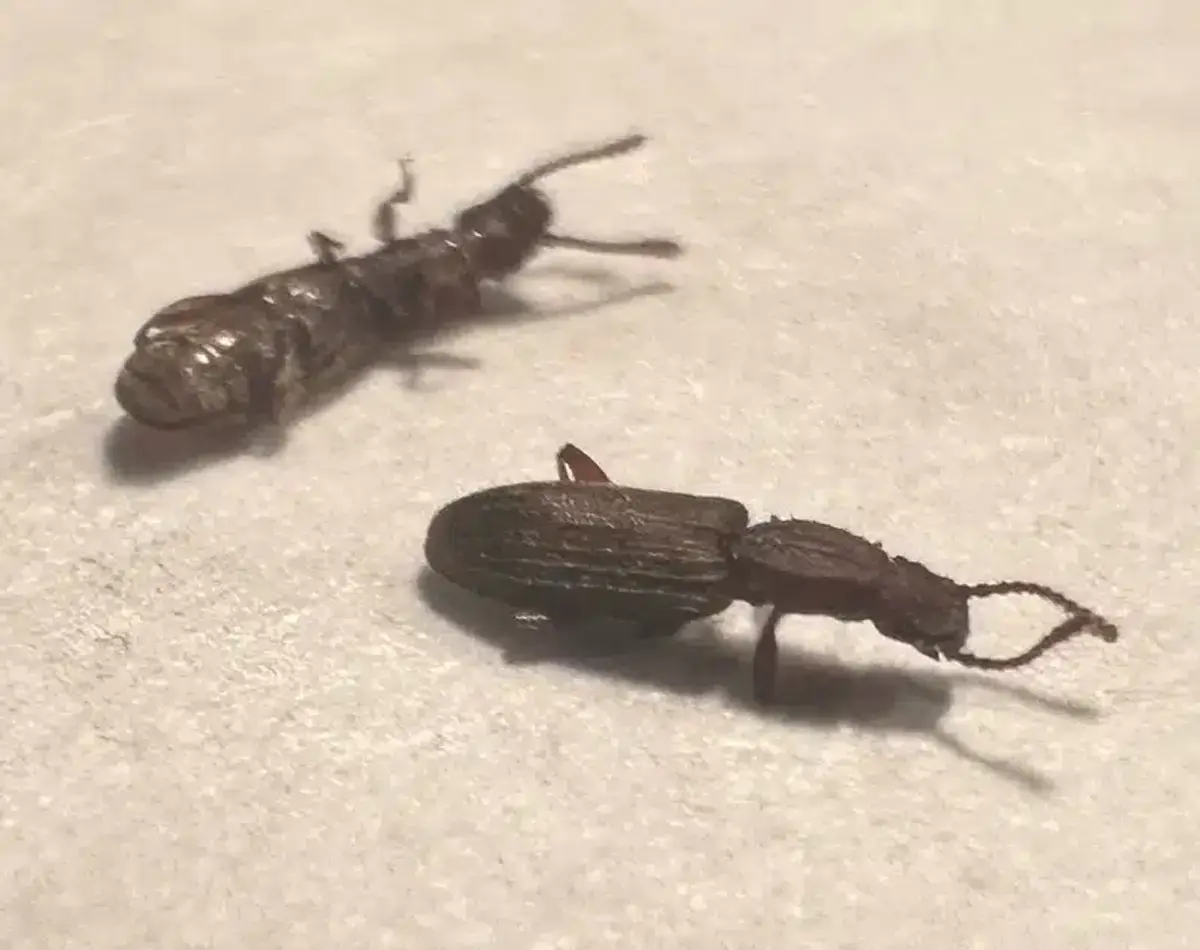
What Are Sawtoothed Grain Beetles?
Sawtoothed grain beetles (Oryzaephilus surinamensis) are small, flattened insects that belong to the silvanidae family. These cosmopolitan pests have spread worldwide through international food trade and are now found in pantries, grain storage facilities, and food processing plants across the globe.
These beetles earned their name from the distinctive six pointed projections along the sides of their thorax that look like tiny saw teeth. This unique feature makes them relatively easy to identify once you know what to look for. As secondary feeders, they can’t bore into whole, undamaged grains but thrive on processed foods and products with existing damage.
Unlike some pantry pests that are seasonal visitors, sawtoothed grain beetles can remain active year-round in heated homes. This means they can continue breeding and expanding their population even during winter months when outdoor temperatures would normally slow their development.
Identifying Sawtoothed Grain Beetle Pest
Proper identification is the first step in addressing any pantry pest problem. Sawtoothed grain beetles have several distinctive characteristics that set them apart from other common stored product pests.
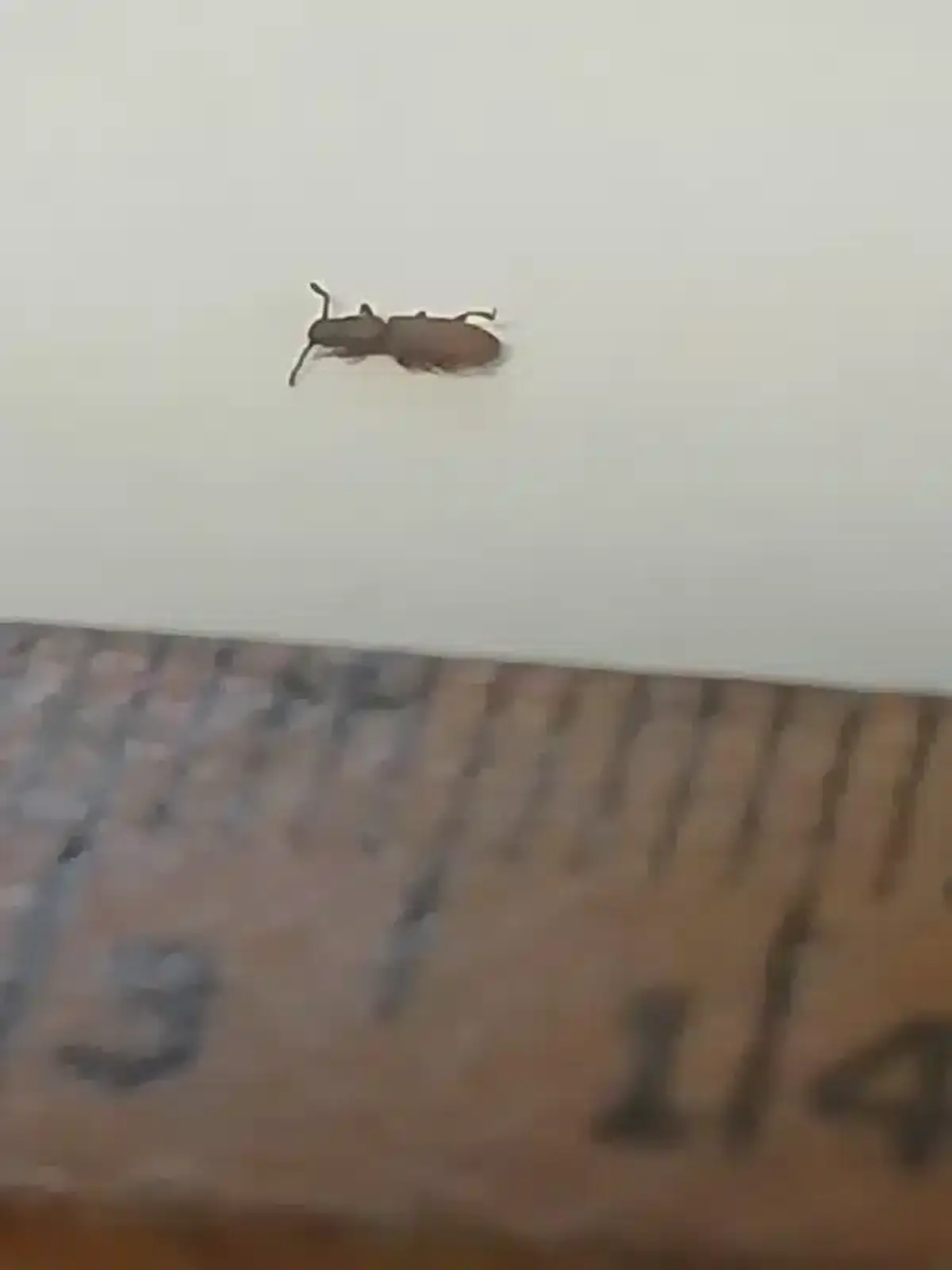
Adult Beetle Features
Adult sawtoothed grain beetles measure just 2-3 millimeters in length - about the size of a pinhead. Their bodies are dark brown to reddish-brown in color and notably flattened, which allows them to squeeze into incredibly tight spaces. The most identifying feature is the series of six sharp, triangular projections along each side of their thorax.
These beetles are flightless, meaning they spread through crawling and hitchhiking on infested products. Their flat bodies make them particularly good at hiding in cracks, crevices, and the seams of packaging materials.
Larvae and Eggs
Sawtoothed grain beetle larvae are slender, yellow-white creatures with brown heads that grow to about 3mm when fully developed. They’re often found directly in food products where the female beetles laid their eggs. The eggs themselves are tiny, capsule-shaped structures about 0.7mm long that are laid singly or in small clusters directly in food sources.
When larvae are ready to pupate, they create crude cells from food particles. You might notice the cast larval skin still attached to these pupation sites, which can be another sign of infestation.
Common Food Sources and Infestation Sites
Sawtoothed grain beetles have diverse appetites when it comes to processed foods. Understanding their preferred food sources helps you know where to look during inspections and which products to prioritize for proper storage.
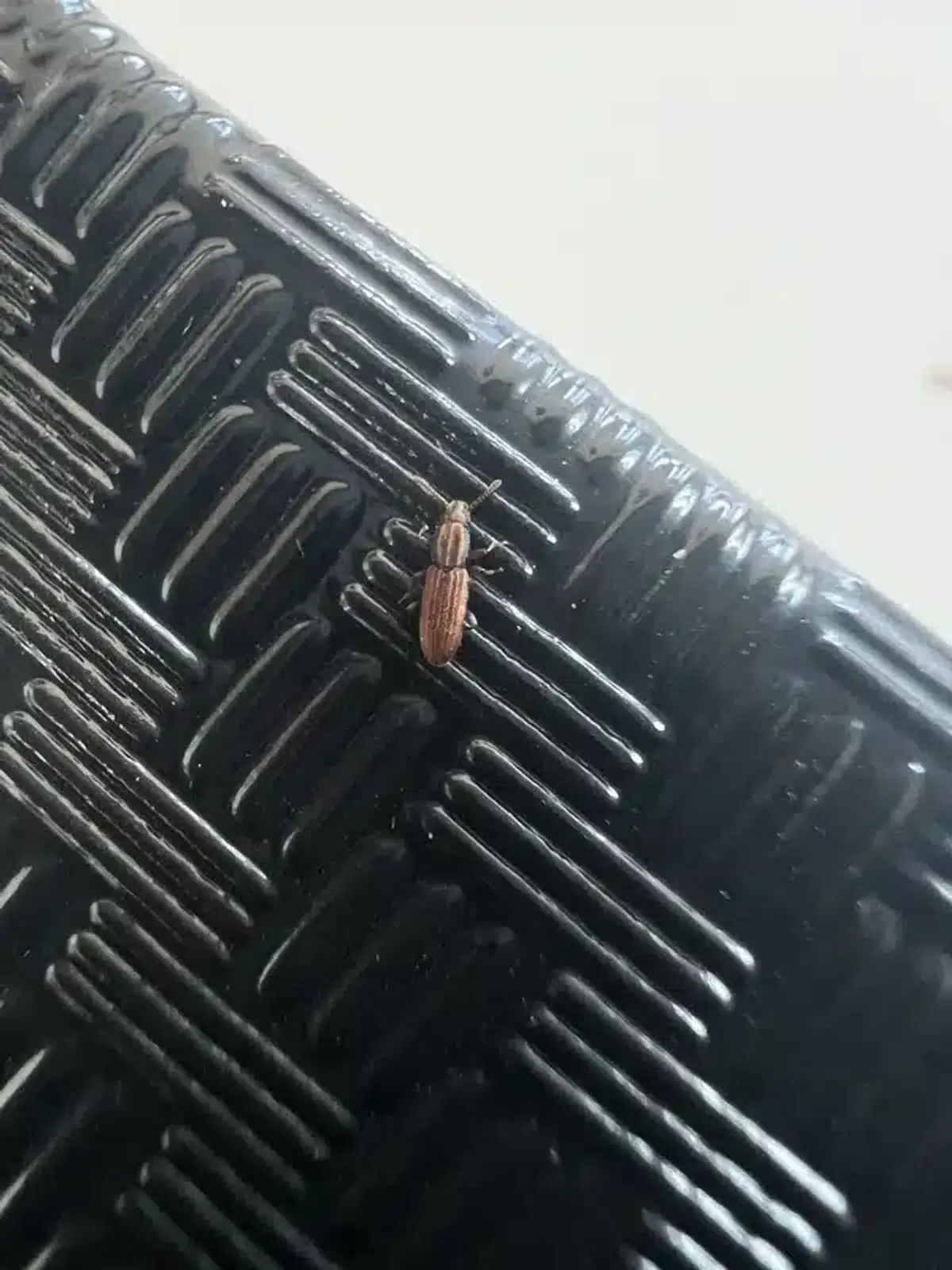
High-Risk Food Products
These beetles particularly favor processed grain products including cereals, flour, pasta, rice, and crackers. However, their diet extends well beyond grains. Nuts, dried fruits, chocolate, spices, and even pet food can become infested. I’ve also encountered them in bird seed, fish food, and dried tobacco products.
Pet food stored in garages or basements creates especially favorable conditions. The combination of accessible food and temperature fluctuations in these areas can lead to rapid population growth that eventually spreads into the main living areas.
How They Enter Packaging
One of the most frustrating aspects of sawtoothed grain beetle infestations is finding them in supposedly sealed packages. These beetles don’t actually chew through packaging materials. Instead, they exploit tiny flaws in packaging that are often invisible to the naked eye.
These beetles exploit packaging flaws that are often invisible to the naked eye. Heat-seal imperfections, microscopic tears in plastic films, and loose cardboard seams all provide entry points for these persistent pests.
What does the science say?
According to research published in the Journal of Stored Products Research, gaps as small as 0.4mm can allow entry for sawtoothed grain beetles, and first-instar larvae can crawl through these openings from up to 1cm away. This explains why seemingly sealed packages can become infested - the entry points are microscopic and exploit manufacturing imperfections that occur during normal packaging processes.
Sawtoothed Grain Beetle Life Cycle and Reproduction
Understanding the sawtoothed grain beetle life cycle helps explain why infestations can seem to explode overnight and why thorough elimination requires patience and persistence.
Development Timeline
Under optimal conditions of 30-35°C (86-95°F), sawtoothed grain beetle eggs hatch in just 3-5 days. The larval period lasts 12-15 days, followed by 4-5 days of pupation. This means a complete generation can develop in approximately 25 days during warm summer conditions.
Female beetles are remarkably productive, laying between 45-285 eggs during their lifetime, with an average of around 250 eggs per female. Adults can live 6-10 months under normal conditions, and some exceptional individuals survive up to three years.
Environmental Factors
Temperature plays a crucial role in sawtoothed grain beetle development. Development stops below 17°C and above 40°C, but the insects can tolerate freezing temperatures for short periods. All life stages die when exposed to -15.6°C for 24 hours, which forms the basis for freezing treatments.
In the humid Mid-Atlantic climate, summer conditions in unair-conditioned spaces often exceed the optimal range for rapid beetle development. This means infestations can produce six or more generations per year in heated homes.
Essential Life Cycle Facts
- Complete Generation: Can develop from egg to adult in just 25 days under optimal conditions
- Egg Production: Females lay 45-285 eggs directly in food sources throughout their lifetime
- Temperature Sensitivity: Development stops below 17°C (63°F) and above 40°C (104°F)
- Survival Rate: All life stages die when exposed to -15.6°C (4°F) for 24 hours
Distinguishing From Similar Pests
Several other small beetles can be found in pantries, making accurate identification important for effective treatment. Each species has slightly different habits and treatment requirements.
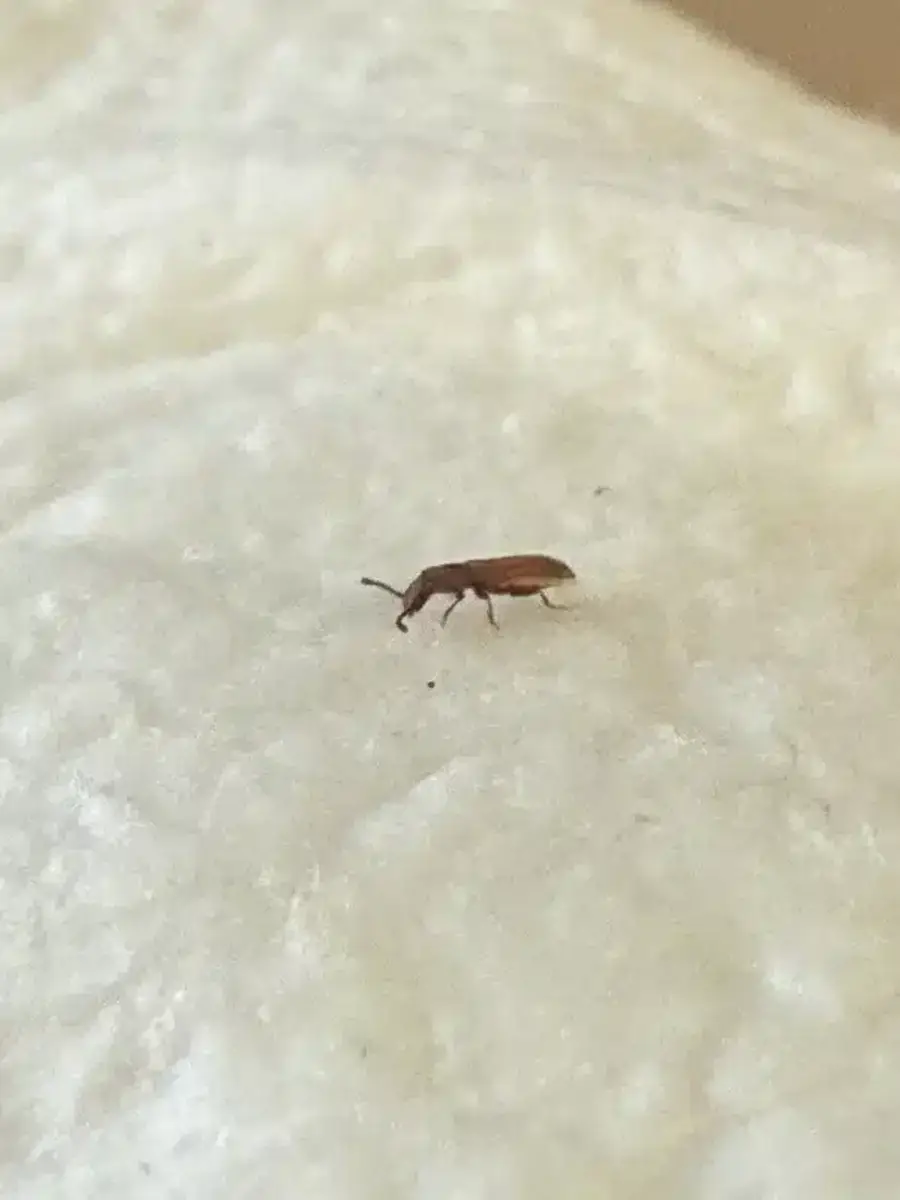

Merchant Grain Beetles
Merchant grain beetles (Oryzaephilus mercator) are the closest relatives to sawtoothed grain beetles and look nearly identical. The key difference is that merchant grain beetles have larger, more prominent eyes and can fly, while sawtoothed grain beetles are flightless. Both species have the characteristic six thoracic projections.
Flour Beetles and Other Pantry Pests
Flour beetles (Tribolium species) lack the distinctive saw-toothed projections entirely and have a more rounded body shape. Their larvae also differ significantly - flour beetle larvae have pointed tail spines, while sawtoothed grain beetle larvae end bluntly.
Other pantry pests like pantry moths and carpet beetle larvae have completely different appearances and life cycles, making them easier to distinguish once you know what to look for.
Systematic Inspection Process
Effective sawtoothed grain beetle control starts with a thorough inspection to identify all infested products and potential breeding sites. This step-by-step approach ensures you don’t miss hidden populations that could restart the infestation.
Preparing for Inspection
Begin by emptying all pantry shelves and cabinets where you suspect beetle activity. Work over white paper or light-colored surfaces to make small beetles more visible. Good lighting is essential - use a flashlight to examine dark corners and crevices.
Focus first on high-risk products including whole wheat flour, oats, cereals, and any items past their “best-by” dates. However, don’t overlook seemingly unlikely sources like spices, dried fruits, or decorative corn displays.
What to Look For
Live beetles are the most obvious sign, but you’ll also want to watch for larvae, which appear as small whitish grubs with brown heads. Look for fine, sawdust-like frass (insect waste) and small holes in packaging. Sometimes you’ll notice a slightly sweet, musty odor in heavily infested products.
Pay special attention to package seams, corners, and any areas where food particles might accumulate. Careful package inspection often reveals signs of infestation before you open the container.
Effective Elimination Strategies for Grain Beetle Pest
Successfully eliminating sawtoothed grain beetles requires a combination of immediate removal of infested materials and long-term prevention strategies. Half-measures often lead to re-infestation from overlooked sources.
Disposal Procedures
All infested products must be completely removed from your home. Don’t try to save partially infested items by sifting out the beetles - eggs and larvae are too small to see reliably. Bag everything tightly before taking it outside to prevent beetles from escaping during transport.
For extra protection, freeze infested items at 0°F (-18°C) for at least 6 days before disposal. This ensures all life stages are dead and won’t establish new populations in your trash area or compost.
Cleaning and Sanitation
After removing infested products, thoroughly vacuum all shelves, paying special attention to corners, shelf pin holes, and any cracks or crevices. Don’t just wipe surfaces - flour dust and food particles can create a paste when wet that actually shelters remaining eggs.
Use your vacuum’s crevice tool to extract debris from tight spaces where larvae might pupate. After vacuuming, either dispose of the vacuum bag immediately or freeze it for 24 hours to kill any beetles that might be inside.
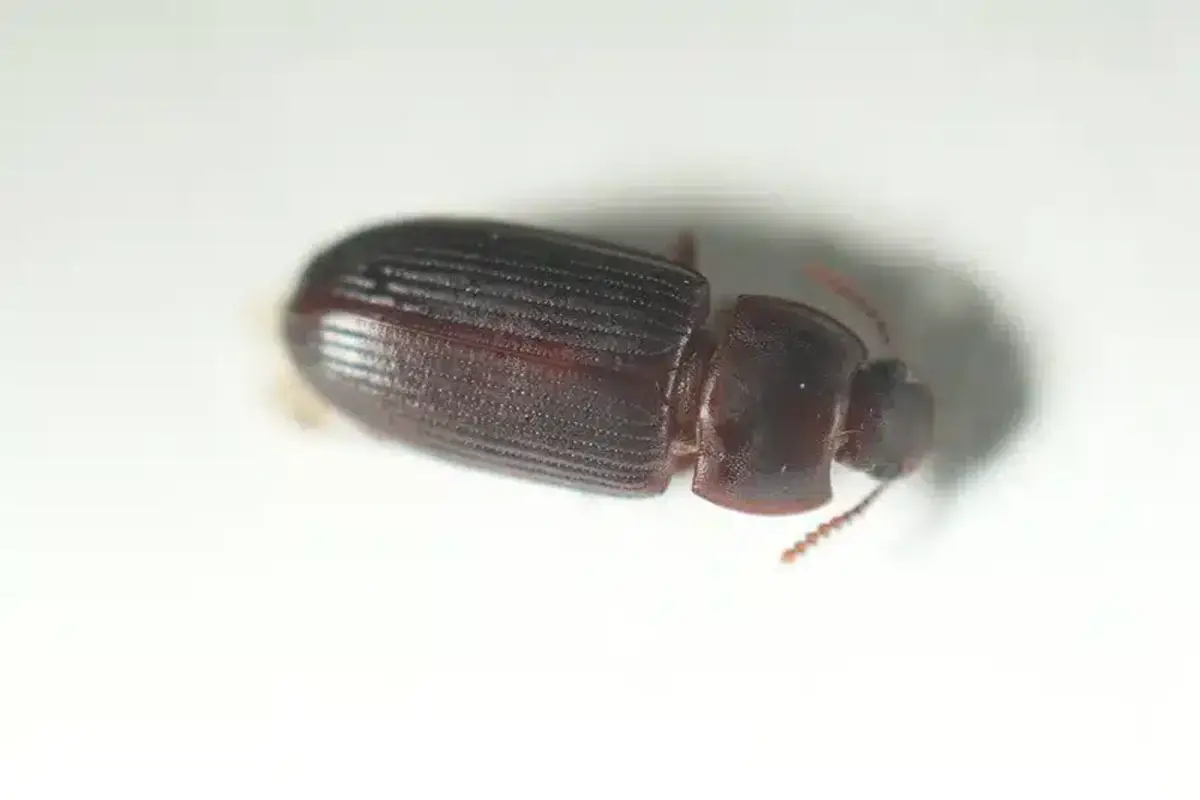
Prevention and Long-Term Grain Beetle Pest Control
Preventing future sawtoothed grain beetle infestations is much easier than eliminating established populations. These strategies focus on eliminating conditions that allow beetles to establish and reproduce.
Proper Storage Techniques
Transfer susceptible foods into rigid containers with tight-fitting lids immediately after purchase. Glass jars and thick-walled polypropylene containers with gasket seals work best because beetles cannot exploit the silicone seal like they can packaging flaws.
Rotate your stock regularly, using older products first and buying only quantities you’ll consume within 2-3 months. This prevents products from sitting long enough for beetles to complete multiple generations even if they do gain access.
Environmental Controls
Keep pantry areas as cool and dry as possible. Maintaining relative humidity below 55% and temperatures below 20°C (68°F) significantly slows beetle development. A small dehumidifier in basement storage areas can make a dramatic difference in coastal Maryland and Virginia homes.
Store bulk items like pet food and bird seed in climate-controlled areas rather than garages or sheds where temperature fluctuations create ideal breeding conditions.
Monitoring and Early Detection
Setting up monitoring systems helps you catch new infestations before they become serious problems. This is especially important if you’ve had previous issues or live in an area with frequent beetle activity.
Pheromone Traps
Research has identified the specific pheromone compounds that attract sawtoothed grain beetles, leading to effective synthetic lures. Place dome-style or pitfall traps 2-5 meters apart in storage areas, replacing lures every 90 days.
Begin monitoring when indoor temperatures consistently exceed 13°C (55°F), as this is when beetle activity increases significantly. Traps won’t eliminate existing infestations but provide early warning of new problems.
Regular Inspection Schedule
Check stored products monthly, especially during warm weather. Look for any signs of package damage, unusual odors, or live insects. This regular attention helps you catch problems when they’re small and manageable rather than waiting until beetles are crawling across your counters.
Professional Treatment Options
While many sawtoothed grain beetle infestations can be managed through sanitation and prevention, severe cases may require professional intervention. Our registered technicians have access to specialized tools and treatments that aren’t available to homeowners.
When to Call Professionals
Consider professional help if you continue finding beetles after thorough cleaning and disposal of infested products, if the infestation covers multiple rooms or storage areas, or if you suspect beetles are breeding in wall voids or other inaccessible areas.
Our family business has been serving the DMV area for over 50 years, and we’ve developed effective protocols for addressing even the most stubborn pantry pest problems. We use products that have passed through our internal research team and meet our strict standards for use in family homes.
Treatment Methods
Professional treatment typically involves crack-and-crevice applications of residual insecticides to areas where beetles might harbor or travel. We never contaminate food contact surfaces and always follow strict protocols to ensure your family’s wellbeing.
In severe cases, we might recommend fumigation for large storage areas, though this requires specialized licensing and is reserved for situations where other methods haven’t been effective.
Seasonal Considerations in the Mid-Atlantic
Living in Virginia, Maryland, or DC means dealing with hot, humid summers that create ideal conditions for sawtoothed grain beetle reproduction. Understanding these seasonal patterns helps you time your prevention efforts effectively.
Summer Peak Activity
We typically see the highest number of homeowner complaints between July and September when kitchen temperatures average 27-32°C and humidity exceeds 70%. During these months, be extra vigilant about checking stored products and maintaining cool, dry storage conditions.
Air conditioning isn’t just about comfort - it’s also an effective pest management tool. Keeping your home consistently cool during summer months dramatically slows beetle development and reproduction.
Winter Considerations
Don’t assume cold weather eliminates your beetle problems. In heated homes, these pests remain active year-round. Winter infestations often originate from pet food stored in mudrooms or basements that hover around 18°C - warm enough for continued activity but often overlooked during inspections.
Similar to how we handle other household pests like carpet beetles and silverfish, winter is actually an excellent time for thorough inspections since beetles may be more concentrated in their preferred hiding spots.
Health and Safety Considerations
While discovering beetles in your food is unpleasant, it’s important to understand the actual health risks involved. Sawtoothed grain beetles are primarily nuisance and sanitation pests rather than disease vectors.
Food Safety Impact
The main concern with sawtoothed grain beetle infestations is food quality degradation rather than disease transmission. Beetle activity increases moisture content in stored products, which can lead to secondary mold growth that poses more serious health risks than the beetles themselves.
Contaminated products should always be discarded, but accidentally consuming a few beetles won’t cause illness. However, people with allergies might experience reactions to beetle fragments or waste products in heavily infested foods.
Treatment Safety
All products we use for sawtoothed grain beetle control are EPA-approved and have passed through our internal research team’s safety evaluation. We’ve eliminated 9 of the harshest chemicals commonly used in our industry, choosing alternatives that we’d feel comfortable using in our own homes.

Successfully managing sawtoothed grain beetle infestations requires understanding their biology, identifying all sources, and implementing comprehensive prevention strategies. The key message is simple: find the source, dispose of it properly, clean thoroughly, and store remaining products in sealed containers.
Remember that these beetles are nuisance pests that indicate sanitation issues rather than serious health threats. With proper identification, systematic elimination, and ongoing prevention, you can protect your pantry from future infestations and enjoy peace of mind about your stored food products.
If you’re dealing with persistent beetle problems or want professional assistance with inspection and treatment, don’t hesitate to reach out. Our registered technicians have the experience and tools to address even challenging infestations while keeping your family’s wellbeing as the top priority. For questions about sawtoothed grain beetle control or to schedule an inspection, call us at 703-683-2000 or email info@bettertermite.com.
Frequently Asked Questions
How did sawtoothed grain beetles get into my sealed packages?
+
Sawtoothed grain beetles don't chew through packaging but enter through tiny flaws as small as 0.4mm. These microscopic gaps occur at heat seals, cardboard seams, and plastic film imperfections during manufacturing or shipping. Even packages that appear completely sealed can have these invisible entry points.
Can I save food that has sawtoothed grain beetles by picking them out?
+
No, you should discard all infested products completely. Beetle eggs and larvae are too small to see reliably, and attempting to salvage food often leads to continued infestation. The presence of beetles also indicates possible contamination with waste products and increased moisture that can promote mold growth.
How long does it take to eliminate a sawtoothed grain beetle infestation?
+
Complete elimination typically takes 2-8 weeks depending on the severity of the infestation and how thoroughly you remove all sources. You might continue seeing occasional beetles for several weeks as remaining eggs hatch, but numbers should decrease steadily if all infested products have been removed.
What's the difference between sawtoothed grain beetles and flour beetles?
+
The main difference is the six sharp projections along the thorax of sawtoothed grain beetles, which flour beetles lack entirely. Flour beetles also have more rounded bodies, while sawtoothed grain beetles are notably flattened. Additionally, their larvae differ - flour beetle larvae have pointed tail spines while sawtoothed grain beetle larvae end bluntly.
Will freezing kill sawtoothed grain beetles in infested products?
+
Yes, freezing at 0°F (-18°C) for at least 6 days will kill all life stages of sawtoothed grain beetles. However, the dead insects and their waste products remain in the food, so frozen items should still be discarded rather than consumed. Freezing is mainly useful to prevent live beetles from escaping during disposal.
Do sawtoothed grain beetles carry diseases?
+
Sawtoothed grain beetles are not known to transmit diseases to humans. They're primarily nuisance and sanitation pests. The main health concern is food quality degradation and potential secondary mold growth in infested products, which poses greater health risks than the beetles themselves.
What temperature kills sawtoothed grain beetles?
+
All life stages die when exposed to -15.6°C (4°F) for 24 hours. Heat treatment at 57°C (135°F) for 1 hour is also lethal. Development stops below 17°C (63°F) and above 40°C (104°F), so maintaining cool storage temperatures significantly slows reproduction without killing them.
How can I prevent sawtoothed grain beetles from returning?
+
Store all susceptible foods in rigid containers with tight-fitting gasket seals, rotate stock regularly using older products first, keep storage areas cool and dry below 55% humidity, and inspect new purchases before bringing them into your pantry. Monthly inspections help catch new problems early.
Should I throw away all my pantry items if I find sawtoothed grain beetles?
+
Only discard products that show signs of infestation - live or dead beetles, larvae, small holes, or unusual odors. Carefully inspect each item individually over white paper, tapping containers to check for movement. Items without signs of infestation can be transferred to sealed containers and monitored closely.
When should I call a professional for sawtoothed grain beetle control?
+
Consider professional help if beetles continue appearing after thorough cleaning and disposal, if the infestation spans multiple rooms, or if you suspect breeding in wall voids or other inaccessible areas. Professional treatment is also recommended for businesses or large storage facilities where infestations can cause significant economic losses.
With five years of hands-on experience in the pest control industry, George Schulz is a registered technician with the Virginia Pest Management Association and a proud third-generation professional in a family business that's been protecting homes for over 57 years. He manages and trains a team of service pros while also leading internal research efforts—recently spearheading a deep-dive review of thousands of documents on pest control materials to hand-pick the most kid and pet friendly, most effective solutions tailored specifically for homes in the DC metro area.
